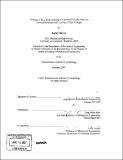Changes in the cation ordering of layered O3 Lix̳Ni₀.₅Mn₀.₅O₂ during electrochemical cycling to high voltages
Author(s)
Li, Hayley Han
DownloadFull printable version (10.58Mb)
Other Contributors
Massachusetts Institute of Technology. Dept. of Mechanical Engineering.
Advisor
Yang Shao-Horn.
Terms of use
Metadata
Show full item recordAbstract
Selected area electron diffraction patterns were collected from a pristine LiNi₀.₅Mn₀.₅O₂ sample and cycled Lix̳Ni₀.₅Mn₀.₅O₂ samples to 4.5 V and 5.3 V in the charged and discharged states. In the pristine sample, the single-crystal diffraction patterns clearly revealed superlattice reflections consistent with a ... supercell that is characteristic of cation ordering in the transition metal layer. Furthermore, these superlattice reflections were found to have considerably weakened or completely disappeared in the charged samples. Comparing the 4.5 V and 5.3 V charged samples, fewer crystals in the 5.3 V charged sample were found to exhibit these superlattice reflections. Another difference is that additional superlattice reflections consistent with the 01 phase with hexagonal-close-packed oxygen array were detected in the 5.3 V but not in the 4.5 V charged sample. Therefore, electron diffraction evidence was found to support the concept of Ni migration from the Li to the transition metal layer, and to confirm the increased Ni occupancy in the transition metal layer upon charging. In addition, electron diffraction data showed that Ni migration was in part reversible upon discharge as demonstrated by the increase in the fractions of crystals exhibiting the ... superlattice reflections from the charged to the discharged samples. (cont.) The excellent electrochemical activity and reversibility of LiNi₀.₅Mn₀.₅O₂ having Ni in the Li layer may be attributed to the mobility of Ni ions upon electrochemical cycling. It has been found that high voltage exposure has resulted in higher discharge capacity and better rate capability. In the cycled samples, a new type of superlattice reflections was observed in addition to the ... superlattice reflections. These superlattice reflections are similar for both the charged and the discharged samples, but their origins were believed to differ. For the charged samples, it was proposed that Li, Ni, and vacancies are partially ordered in the tetrahedral sites in a ... supercell with the space group ... Such ordering may improve the stability of the 03 layered structure upon charging to high voltages. For the discharged samples, Li, Ni, and vacancies order mostly in the octahedral sites in an ... cell with the space group P2/m. It was believed that this arrangement may facilitate Li diffusion in the interlayer slab space upon discharge.
Description
Thesis (S.M.)--Massachusetts Institute of Technology, Dept. of Mechanical Engineering, 2007. Pages 124-125 blank. In title on t.p., double-underscored "x" appears as subscript. Includes bibliographical references (p. 95-98).
Date issued
2007Department
Massachusetts Institute of Technology. Department of Mechanical EngineeringPublisher
Massachusetts Institute of Technology
Keywords
Mechanical Engineering.